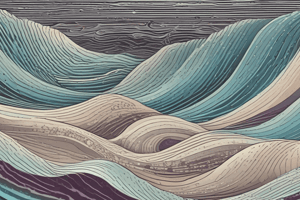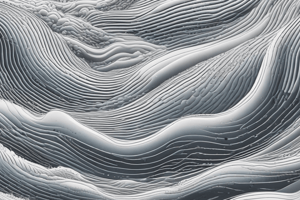Podcast
Questions and Answers
What is the main characteristic of a transverse wave?
What is the main characteristic of a transverse wave?
- The wave has a constant frequency
- The motion of the particles moves at right angles to the direction of the wave (correct)
- The wave has a constant amplitude
- The motion of the particles moves in the same direction as the wave
What is the distance between two consecutive crests or troughs of a transverse wave?
What is the distance between two consecutive crests or troughs of a transverse wave?
- Wavelength (correct)
- Amplitude
- Speed
- Frequency
What type of wave requires a medium to travel?
What type of wave requires a medium to travel?
- Electromagnetic wave
- Longitudinal wave
- Mechanical wave (correct)
- Transverse wave
What is the term for the highest point of a transverse wave?
What is the term for the highest point of a transverse wave?
What is an example of a transverse wave?
What is an example of a transverse wave?
What type of waves are P waves?
What type of waves are P waves?
What is the conclusion drawn from the study of S and P waves?
What is the conclusion drawn from the study of S and P waves?
What type of wave is produced from earthquakes and has both vertical and horizontal components?
What type of wave is produced from earthquakes and has both vertical and horizontal components?
What is the motion of particles in a water wave?
What is the motion of particles in a water wave?
What type of wave can travel through liquids?
What type of wave can travel through liquids?
What is the main difference between electromagnetic waves and other types of transverse waves?
What is the main difference between electromagnetic waves and other types of transverse waves?
What is the direction of particle movement in a longitudinal wave?
What is the direction of particle movement in a longitudinal wave?
What type of wave can only travel through solids?
What type of wave can only travel through solids?
What is the term for the areas of high pressure in a longitudinal wave?
What is the term for the areas of high pressure in a longitudinal wave?
What type of wave is sound?
What type of wave is sound?
Flashcards are hidden until you start studying
Study Notes
What is a Transverse Wave?
- A transverse wave is a wave in which the motion of the particles moves at right angles to the direction the wave is moving.
- It looks like a sine or cosine curve, with a highest point called the crest and a lowest point called the trough.
- The distance between two crests or two troughs is called the wavelength of the wave.
Examples of Transverse Waves
- Transverse waves can be made by moving one end of a string side to side or up and down.
- Examples of transverse waves include vibrations of strings on a guitar and ripples on the surface of water.
Types of Transverse Waves
- Mechanical waves require a medium to travel through and cannot travel in a vacuum.
- Electromagnetic waves do not require a medium and can transmit energy through a vacuum.
- Examples of electromagnetic waves include sunlight, radio waves, microwaves, and X-rays.
Transverse Wave vs. Longitudinal Wave
- In transverse waves, particle movement is perpendicular to the direction of the wave.
- In longitudinal waves, particle movement is parallel to the direction of the wave.
- Longitudinal waves are formed by the compression of particles, and examples include sound waves.
Longitudinal Waves
- Longitudinal waves have areas of high pressure called compressions and areas of low pressure called rarefactions.
- The wavelength of longitudinal waves can be determined by measuring the distance between two compressions or two rarefactions.
Longitudinal and Transverse Wave Diagrams
- Longitudinal and transverse waves both transfer energy from one place to another, but they do it in different ways.
Longitudinal and Transverse Wave Movement
- Transverse waves only move through solids, while longitudinal waves can move through solids, liquids, and gases.
Examples of Longitudinal and Transverse Waves
- Earthquakes produce both longitudinal (P waves) and transverse (S waves) waves, which helped determine that the Earth's core consists of a liquid.
- Rayleigh waves are a combination of transverse and longitudinal waves, with both vertical and horizontal components to their direction.
- Surface waves, such as ocean waves, are also a combination of longitudinal and transverse waves.
Studying That Suits You
Use AI to generate personalized quizzes and flashcards to suit your learning preferences.




